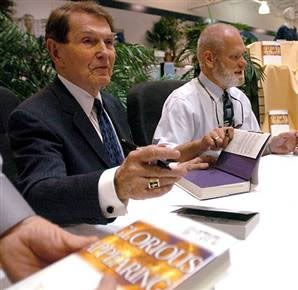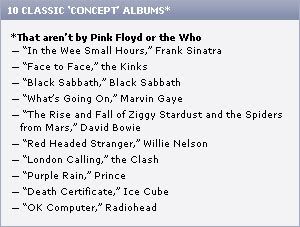Our favorite films that pull the old switcheroo!By Kim MorganSpecial to MSN MoviesWhat makes for a true twist ending in a movie? Is it merely a shocking jolt of amazement? Is it that moment of recognition the movie was seeking? Is it... "Rosebud?"
It can be all these things and more, provided the picture's story is greatly altered by the final, shocking disclosure. It should also smack audiences with a "never saw that coming" wallop. And it should never be abused.
M. Night Shyamalan, who's so well known for the twist ending that he's become almost an irritating brand, has promised no such thing with his latest, "
Lady in the Water," but then, is that the twist? Is he deceiving us? We'll just have to wait and see.
As for now, we've listed 10 of our favorite twist endings. Some are classic, some are new and some are probably surprising. That's right, "
The Usual Suspects" did not make the cut. Hey, we said these were twists.
And be warned: Spoilers lurk below. How could they not?
10. "The Others" (2001) Alejandro Amenabar directed another twisty story with "
Open Your Eyes" (re-made as "
Vanilla Sky"), but his English-language ghost story is something of a modern classic.
Nicole Kidman plays the overprotective mother to two light-sensitive kids who are experiencing all kinds of creepy happenings in their rambling, gothic home. Ghosts talk to them, some even possess them, and the servants are downright weird. Refreshingly old-fashioned and deeply sad, the film's grim, rather bold ending reveals that Kidman's nervous manner is based on the fact that she and her children are not only ghosts themselves but victims of her murder-suicide. "The Others" is both powerfully unsettling and incredibly underrated.
9. "Suspicion" (1941)This is the strange case of
Alfred Hitchcock being forced to create a new twist ending based on studio insistence. And though the resulting finality is altogether weird, almost non-nonsensical, I'm arguing its value for the film's terrifically tense atmosphere and sequences (that glass of "poisoned" milk!) and for simply being so off-putting and surprising.
Joan Fontaine stars as a mousy (though pretty) poor little rich girl who's sure to live the life of a spinster until wolfish charmer
Cary Grant sets eyes on her. The mismatched pair marry and the resulting story pits an understandably concerned Fontaine against a husband who's not only a wastrel -- he gambles away their dough, steals from his job and generally embodies every trait of a bad apple -- he's probably going to kill her. But wait a second ... no, we were wrong. He actually loves the woman he calls "monkey face" and clearly she must be paranoid. Huh? In the original story, Fontaine was to willingly drink a glass of poisoned milk, sacrificing herself for the cad she loves, but RKO couldn't stomach an evil Grant. Hitchcock ditched this darker and much more congruous ending with Grant and Fontaine enduring a wild car ride that paints Grant as savior. A twist for Hitchcock, a twist for the studio and a twist for the audience, "Suspicion" remains intriguingly baffling.
8. "Charade" (1963)A tremendously charming cat-and-mouse thriller/romantic comedy that, once again, makes Cary Grant the good guy, "Charade" soars from a twist that's wonderfully endearing. Elegant
Audrey Hepburn plays a woman who becomes embroiled in a nefarious mystery after her husband (whom she planned on divorcing) is murdered. All kinds of scary men are now after the penniless widow (including a memorable
James Coburn,
Ned Glass and
George Kennedy) and the vulnerable women must wonder -- are these men seeking her or the hidden money her husband's left behind? And then there's Grant, a suave enigma who appears to be helping her, or is he? Well, he is, eliciting this famous utterance from Hepburn: "Oh, I love you, Adam... Alex... Peter... Brian... Whatever your name is."
7. "Psycho" (1960)Yeah, yeah, we all know "Psycho" is a masterpiece of shock. We also know that it's not even a spoiler for us to reveal that, yep, Norman Bates' overbearing, murderous mother is actually... Norman Bates. But to see the film in 1960! Imagine what that must have been like for theatergoers unaccustomed to the film's star,
Janet Leigh, being murdered midway through the picture and weird Anthony Perkins running around in a dress. Though "Psycho" begs an argument between the twist ending over the shock ending, it did make audiences re-think everything that preceded the cross-dressing revelation. And its influence on the horror genre is immense.
6. "Witness for the Prosecution" (1957)The courtroom drama has always used the twist, turn and shock (think "
And Justice for All..." or "
Primal Fear") but none was more entertainingly convoluted than
Billy Wilder's "Witness for the Prosecution." It's a film in which the characters' somewhat campy performances actually make sense by the end, and it remains tense, poignant and darkly funny to this day. How to explain? We'll keep it as simple as possible.
Tyrone Power (in the performance of his life) stands accused of killing a wealthy widow, while his crusty, heart-attack prone barrister (
Charles Laughton) attempts to sort out the details. His first surprise occurs when Power's bitchy wife (played by
Marlene Dietrich) testifies against her husband. He's baffled and so are we. But damn if we're not on the edge of our seat through the entire picture. With outbreaks galore and a few major surprises (Laughton's defending the wrong guy! Dietrich stabs Powers in court!), you have to love a movie with end credits that plead: "Please do not reveal the shock ending to your friends."
5. "Unbreakable" (2000)We know, we know. You're wondering, out of all the
M. Night Shyamalan pictures, why in the hell did we chose the movie many critics panned (well, before they aptly trashed "
The Village") and not his little twist-ending milestone, "
The Sixth Sense." Our reason? It's simple -- "Unbreakable" is a better film. And the twist is much more interesting, mythic and emotional. It also manages to be one of the best examples of cinematic comic book origins without an actual existing comic book source material from which to draw.
Bruce Willis plays a security guard who not only miraculously survives a fatal train accident but with nary a scratch on his body. And further, he (a la
Peter Weir's "
Fearless") realizes newfound special powers after the wreck. What's going on? An eccentric comic book art dealer with an injurious bone disorder (played beautifully by
Samuel L. Jackson) provides the explanation -- Willis is the incarnation of a real superhero. The film's reveal is potently surprising, when the supposedly vulnerable, immensely likeable and highly sympathetic Jackson turns out to be himself a super-villain, and Willis' arch-nemesis at that. A gritty, bizarro take on the mythic among us, "Unbreakable" deserves a second consideration. And a sequel!
4. "Oldboy" (2003)Adapted from the Japanese manga written by Tsuchiya Garon and illustrated by Minegishi Nobuaaki, Korean director
Park Chan-wook's "Oldboy" is a compelling look at the endless cycle of surrealistic vengeance. The potently sinister tale involves a regular family man, Dae-su Oh (
Choi Min-sik in one of the greatest performances of the new century) who's kidnapped for no reason he can decipher, placed in a cell for 15 years and framed for the murder of his wife. When he's inexplicably set free, his horrifying quest to solve the what's and why's of his lot is riddled (almost literally) by an insane cat-and-mouse game with his bizarre, sadistic former captor, Woo-jin Lee. Dae-su also must cope with an odd woman who takes pity on him and eventually becomes his lover. Immensely violent, gloriously stylized (but with loads of meaning) and at some points, transcendentally thought provoking, the picture finally gives us the one-two gut punch: Dae-su realizes his new lover is actually his long-lost daughter. Brutal. And that his life has taken the turn to crazy town because Woo-jin, a former schoolmate, is still angry over his sister's suicide (she killed herself after Dae-su spread the news that the brother and sister were lovers). Cruelty and karma has never been so inventive. You'll need to pick up your jaw when it ends.
3. "The Crying Game" (1992)A twist so famous, it garnered a Time magazine cover.
Neil Jordan's gritty, lovely and supremely touching masterpiece remains as relevant today as it was nearly 15 years ago.
Stephen Rea is an Irish Republican Army member who, because of his own moral decency, muddles an important mission in Northern Ireland. He escapes for London wishing to start life anew but is nevertheless haunted by an English soldier (a powerful
Forest Whitaker) whom he developed a bond with while holding hostage. When he falls for the lover his hostage asked him to look after, Dil (
Jaye Davidson), the film sets in motion its famous turn -- one that startled many a male moviegoer. Glamorous, world-weary Dil is actually a he. Jordan manages to merge the travails of Northern Ireland with gay club culture to craft an unexpected love story that, in another more meaningful twist, shows that gender doesn't really matter when it comes to love. Stunningly beautiful.
2. "Fight Club" (1999)David Fincher's transgressive, ingenious rebel yell is a superb example of being subversive within the Hollywood system. It also possesses a fantastic twist ending that's so satisfyingly meaningful (and crazy), you almost wish you could erase your memory and watch it for the first time... yet the film keeps getting better with repeated viewings.
Edward Norton is the self-help addicted, mild-mannered corporate drone who finds inspiration in creating Fight Club (a place where guys literally beat the spit and blood out of each other to feel something) with
Brad Pitt's iconic Tyler Durden. But did he form the violent movement with Tyler? Well, no, not really. In fact, Durden is the imagined alter-ego of Norton's splintered psyche, a psychotic manifestation of his rage against society. Working both powerfully potent hard truths with delicious satire, "Fight Club," explosive ending and all, is absolute genius.
1. "Les Diaboliques" (1955)Henri-Georges Clouzot's murder mystery is a masterpiece of suspense, a cleverly constructed accomplishment that's stunningly crafted (all that murky water) and deeply dark. Nastiness, pessimism and odd, irreverent humor abound, as well as one of the most shocking twist endings in the history of cinema. The story involves two very different women with one shared purpose -- to murder a despicable man. A fragile, humiliated head-mistress (
Vera Clouzot) to a boy's school endures the evil wrath of her husband (
Paul Meurisse), who beats students and flaunts his schoolteacher lover (
Simone Signoret) right in front of her. Both women decide they've had enough of this SOB and drown him in a bathtub. But that's just the beginning. When all sorts of disturbing clues pop up that the hubby might not be dead, the women go into existential meltdown, wondering if they're crazy. When he emerges alive from the bathtub, not only do they feel nuts, the audience does as well. Oft-copied and brilliantly perverse, "Les Diaboliques" is, quite literally, a watermark in twisted cinema.
Honorable Mentions: "
Jacob's Ladder," "
The Usual Suspects," "
Angel Heart," "
Planet of the Apes"





 Last month, when my parents sold the house I grew up in, my mom forced me to come home and clear out my childhood bedroom. I opened the closet and found a box the size of a Jetta. It was so heavy that at first I thought it held my Weider dumbbells from middle school. Nope, this was my old stash. Thousands, if not tens of thousands, of baseball cards from the 1980s. Puckett, Henderson, Sandberg, Gwynn, and McGwire stared back at me with fresh faces. So long, old friends, I thought. It's time for me to cash in on these long-held investments. I started calling the lucky card dealers who would soon be bidding on my trove.
Last month, when my parents sold the house I grew up in, my mom forced me to come home and clear out my childhood bedroom. I opened the closet and found a box the size of a Jetta. It was so heavy that at first I thought it held my Weider dumbbells from middle school. Nope, this was my old stash. Thousands, if not tens of thousands, of baseball cards from the 1980s. Puckett, Henderson, Sandberg, Gwynn, and McGwire stared back at me with fresh faces. So long, old friends, I thought. It's time for me to cash in on these long-held investments. I started calling the lucky card dealers who would soon be bidding on my trove.


